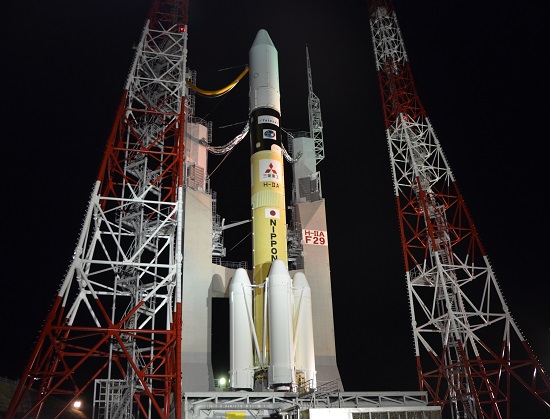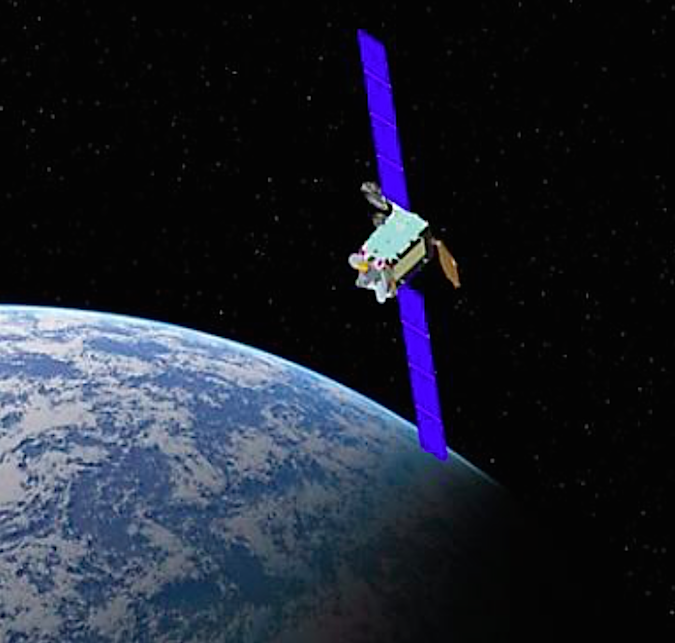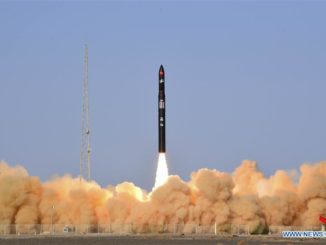
The first communications satellite dedicated to support Japanese military forces will launch Tuesday on top of an H-2A rocket on the way to a perch more than 22,000 miles above Earth.
The advanced spacecraft carries an X-band communications payload to relay messages and serve the command and control network of the Japan Self-Defense Forces.
A Japanese H-2A rocket, built and operated by Mitsubishi Heavy Industries, will launch the powerful DSN 2 communications satellite from the Tanegashima Space Center in southern Japan at 0744 GMT (2:44 a.m. EST) Tuesday.
The launch window, which opens at 4:44 p.m. Japan Standard Time on Tuesday, extends for 74 minutes, and the weather forecast calls for favorable conditions.
The rocket rolled out of its 265-foot-tall (81-meter) assembly building around 1800 GMT (1 p.m. EDT; 3 a.m. Japan Standard Time), approximately 14 hours before the appointed launch time. Riding a mobile launch platform, the H-2A rocket reached its launch pad 1,600 feet (500 meters) from the assembly structure for fueling and other final flight preps.
Standing 174 feet (53 meters) tall, the H-2A rocket will fly in the rarely-used “204” configuration with four strap-on solid rocket boosters. Most H-2A missions take off with two of the solid-fueled motors, but the DSN 2 spacecraft mounted aboard the rocket for Tuesday’s mission requires the power of four boosters.
Tuesday’s launch will mark the 32nd flight of an H-2A rocket, and just the third to fly with the launcher’s most powerful version.
Once the rocket arrived at the launch pad at Tanegashima, the launch team planned to switch on the H-2A’s computer and navigation systems, test the rocket’s range safety mechanisms, and fuel the two-stage launcher with cryogenic liquid hydrogen and liquid oxygen propellants.
A computer-controlled sequencer will take charge of the final minutes of the countdown, switching the rocket to internal battery power and pressurizing its propellant tanks before igniting the first stage’s hydrogen-fueled LE-7A main engine at T-minus 4.7 seconds.
The four boosters mounted around the base of the rocket will ignite about four seconds later to propel the H-2A into the sky.
Riding 2.5 million pounds of thrust, the H-2A rocket will fly east from Tanegashima over the Pacific Ocean, dropping its four boosters into the sea around two minutes after liftoff. At the four-minute point, with the H-2A above the dense lower layers of the atmosphere, the clamshell-like nose fairing at the top of the rocket will jettison to reveal the DSN 2 spacecraft, also known as Kirameki 2.
The launcher’s LE-7A main engine will continue firing with nearly 250,000 pounds of thrust until around T+plus 6 minutes, 36 seconds, when the first stage will shut off and drop away. The second stage’s LE-5B engine will fire for the first of two burns to inject the DSN 2 satellite into the mission’s targeted orbit.
In a break from the public relations practice on most H-2A flights, Japanese officials have not released a second-by-second timeline of Tuesday’s mission, possibly because of the payload’s military nature. If the flight profile follows the track of a typical H-2A launch, the DSN 2 satellite should be deployed from the rocket’s second stage around a half-hour after liftoff.
The size, mass, capabilities and operating position of the DSN 2 spacecraft also have not been revealed.
The Japan Aerospace Exploration Agency has also announced no plans to webcast the launch, as the agency does for scientific and commercial missions.

The satellite will likely be released into an egg-shaped geostationary transfer orbit, with a high point at, or above, an altitude of more than 22,000 miles (35,000 kilometers). DSN 2’s own rocket engine will maneuver the spacecraft into a circular geostationary orbit over the equator, where its communications antennas will reach military units patrolling by land, sea and air across the Asia-Pacific.
The DSN 2 communications station is one of three X-band relay satellites in development by the Japanese Defense Ministry.
The Japanese government designed the program as a “Private Finance Initiative,” in which the satellites and their support network were commercially procured by DSN Corp., a joint venture with majority ownership by SKY Perfect JSAT Corp., a Tokyo-based commercial communications satellite operator.
Officials announced the DSN satellite agreement in January 2013, with satellite builder NEC Corp. and the telecommunications provider NTT listed as minority owners of the new company.
While SKY Perfect JSAT manages the purchase, launch and operation of the DSN satellites, NEC was selected as the prime contractor for the production of the satellites and NTT is in charge of maintaining ground facilities to support the Self-Defense Forces’ new X-band network.
Mitsubishi Electric Co. manufactured the DSN 2 spacecraft chassis, according to information released by SKY Perfect JSAT last year in an earnings report.
The initial agreement, which covered the development, launch and operation of two DSN satellites for 15 years, was valued at 122 billion yen, or approximately $1.1 billion. In the Japanese Defense Ministry’s planned budget for fiscal year 2017, officials disclosed plans to purchase a third X-band communications satellite.
The DSN 1 satellite, a part-military, part-commercial telecom craft, was supposed to launch in mid-2016 on an Ariane 5 rocket.
But the satellite, also named Superbird 8, was damaged during air shipment from Japan to the Ariane 5 launch base in French Guiana, and engineers returned the craft to Japan for repairs, delaying its liftoff by at least a year.
The activation of the DSN satellite network will lessen the Japanese government’s need to lease communications capacity from commercial satellites.
Tuesday’s mission will be the fifth Japanese space launch attempt in less than four months, an unusually busy time for the country’s space program.
The last flight of an H-2A rocket delivered Japan’s Himawari 9 weather satellite to orbit Nov. 2, and Japan’s more powerful H-2B rocket blasted off from Tanegashima Island on Dec. 9 with an HTV supply ship heading for the International Space Station.
A small-class Epsilon rocket successfully launched Dec. 20 from the Uchinoura Space Center on nearby Kyushu Island with a research probe to study the Van Allen radiation belts.
An experimental uprated sounding rocket, modified to put a small CubeSat into orbit, took off Jan. 14 from Uchinoura, but fell into the sea a few minutes later after engineers lost contact with the booster.
Email the author.
Follow Stephen Clark on Twitter: @StephenClark1.



